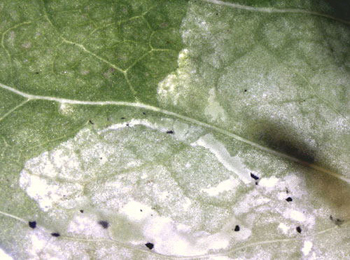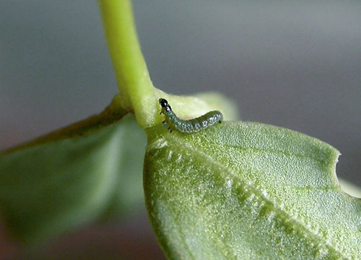|
||||||
|
ONONIS. Restharrows. [Fabaceae] |
|
|
Nine species of Ononis are recorded in Britain. These include the native Small Restharrow (O. reclinata), Common Restharrow (O. repens) and Spiny Restharrow (O. spinosa). The BSBI provide a downloadable plant crib for Ononis. Small Restharrow (O. reclinata) is protected under Schedule 8 of the Wildlife and Countryside Act, 1981. Eight British are recorded on Ononis in Britain. A key to the European miners recorded on Ononis is provided in Bladmineerders van Europa. |
|
Key for the identification of the known mines of British |
Note: Diptera larvae may live in a corridor mine, a corridor-blotch mine, or a blotch mine, but never in a case, a rolled or folded leaf, a tentiform mine or sandwiched between two more or less circular leaf sections in later instars. Pupation never in a cocoon. All mining Diptera larvae are leg-less maggots without a head capsule (see examples). They never have thoracic or abdominal legs. They do not have chewing mouthparts, although they do have a characteristic cephalo-pharyngeal skeleton (see examples), usually visible internally through the body wall. The larvae lie on their sides within the mine and use their pick-like mouthparts to feed on plant tissue. In some corridor miners frass may lie in two rows on alternate sides of the mine. In order to vacate the mine the fully grown larva cuts an exit slit, which is usually semi-circular (see Liriomyza huidobrensis video). The pupa is formed within the hardened last larval skin or puparium and as a result sheaths enclosing head appendages, wings and legs are not visible externally (see examples). See Key to non-Diptera. |
1a > Stem-miner: External stem-mine. |
|
Ophiomyia ononidis Spencer, 1966 [Diptera: Agromyzidae]. |
1b > Leaf-miner: A distinctive mine primarily above mid-rib, with irregular short lateral offshoots into leaf blade. Pupation external (Spencer, 1972: 51 (fig. 172), 55; Spencer, 1976: 270, 271 (fig. 486)). Branched, whitish, upper-surface corridor; main axis overlying the midrib; side branches overlying the main lateral veins. (In Campanula and Phyteuma the mine is much less branched, sometimes nothing more than a corridor on top of the midrib). Frass in rather long strings. Usually the mines begins as a long and narrow, shallow, tortuous lower-surface corridor that ends upon the midrib but otherwise is not associated with the leaf venation. Often this initial corridor is filled with callus, and then even less conspicuous. Pupation outside the mine. A linear mine on the upper surface, usually following the midrib and showing side branches along the veins. The frass is in strings. |
|
Liriomyza strigata (Meigen, 1830) [Diptera: Agromyzidae]. |
1c > Leaf-miner: An upper or lower surface shallow winding linear mine, which may develop into a secondary blotch. Pupation external (Spencer, 1976: 240). Puparium orange Upper- or lower-surface, greenish or whitish corridor, sometimes a blotch. The corridor does not widen much and is not associated with the midrib. Frass in conspicuous thread fragments, alternating along the sides of the corridor. Pupation outside the mine. The mine is also illustrated in British Leafminers. |
|
Liriomyza cicerina (Rondani, 1975) [Diptera: Agromyzidae]. |
1d > Leaf-miner: A short, irregular, linear upper surface mine on any part of the leaf. Also recorded from young pods (Bland, 1997a). Long corridor mine. As a rule the first part of the mine is lower-surface, the later part upper-surface. Often the loops are so dense that a secondary blotch is the result. Because upper- and lower-surface corridor segments often cross, the mine obtains a strange array of transparant patches. There is no association with the midrib. Frass in strings and thread fragments. Pupation outside the mine; exit slit in upper epidermis. Mine not associated with the veins or midrib of the leaf (It is this character which enables distinction from another Agromyzid pest species - Liriomyza huidobriensis). The larvae may leave one leaf (if not large enough) and enter another leaf, via the petiole). It exits the leaf to pupate through a semi-circular slit in the upper surface of the leaf. |
|
Liriomyza bryoniae (Kaltenbach, 1858) [Diptera: Agromyzidae]. |
1e > Leaf miner: An initially lower-surface linear leaf-mine, which later develops into large whitish blotch and appears pale and mottled from above, due to the variable depth of larval feeding. Less frequently feeding in upper surface or stem (Spencer, 1972b: 37, fig. 112); Spencer, 1976: 118). The mine starts as a superficial lower-surface corridor. After its first moult the larva starts making a blotch, often close to the base of the leaflet. The blotch in principle is lower-surface, but may be interparenchymatous for some part. Moreover, in places the larva feeds from the palissade parenchyma. Seen from above the leaf appears mottled. The overall result is that the mine, despite its considerable size, is hard to find. The easiest way is to hold the leaves against the light: the large larvae than are conspicuous. Frass in coarse grains, both in the corridor and in the blotch; in the corridor they are widely spaced. Pupation outside the mine. Puparium reddish |
 Part of mine of Agromyza lathyri on Pisum sativum Image: © Willem Ellis (Bladmineerders van Europa) |
|
Agromyza lathyri Hendel, 1923 [Diptera: Agromyzidae]. |
|
Key for the identification of the known mines of British |
Note: The larvae of mining Coleoptera, Hymenoptera and Lepidoptera may live in a corridor mine, a corridor-blotch mine, a blotch mine, a case, a rolled or folded leaf, a tentiform mine or sandwiched between two more or less circular leaf sections in later instars. Larva may pupate in a silk cocoon. The larva may have six legs (although they may be reduced or absent), a head capsule and chewing mouthparts with opposable mandibles (see video of a gracillarid larva feeding). Larvae of Hymenoptera and Lepidoptera usually also have abdominal legs (see examples). Frass, if present, never in two rows. Unless feeding externally from within a case the larva usually vacates the mine by chewing an exit hole. Pupa with visible head appendages, wings and legs which lie in sheaths (see examples). |
1a > Leaf-miner: The first generation initially forms an unmistakable leaf-mine on Anthyllis vulneraria, but the second generation feeds on the flowers. Feeding signs on other plants vary in appearance. Larvae can move between sewn leaves, and more than one larva may be found together. Larvae in a small full depth blotch, often with extensions. Frass concentrated in one corner of the mine. The mining activities may cause the leaf to roll inwards. Older larvae live free among spun leaves, but still they may make then full depth mines by feeding on the leaf tissue from a small opening. |
 Aproaerema anthyllidella larva, dorsal Image: © Steve Wullaert (Bladmineerders van Europa) |
|
Aproaerema anthyllidella (Hübner, 1813) [Lepidoptera: Gelechiidae]. |
1b > Leaf-miner: The mine begins as a tiny, lower-surface epidermal corridor. Only after the first moult the larva starts feeding on the leaf parenchyma. The first result is a corridor overlying the midrib. From here branches enter the leaf disk; gradually they widen and merge, laeving in the end almost the entire leaf mined out. Almost all frass is ejected. The larva can leave its mine and make a new one elsewhere. Pupation witin the mine. |
|
Parectopa ononidis (Zeller, 1839) [Lepidoptera: Gracillariidae]. |
1c > Leaf-miner: Lower surface tentiform mine that occupies only part of a leaflet. In full grown leaves the mine is strongly inflated and is largely hidden by the leaf. Unlike other species the entire leaflet is not mined out. |
|
| Phyllonorycter insignitella (Zeller, 1846) [Lepidoptera: Incurvariidae]. |
| Last updated 06-Jul-2019 Brian Pitkin | ||

